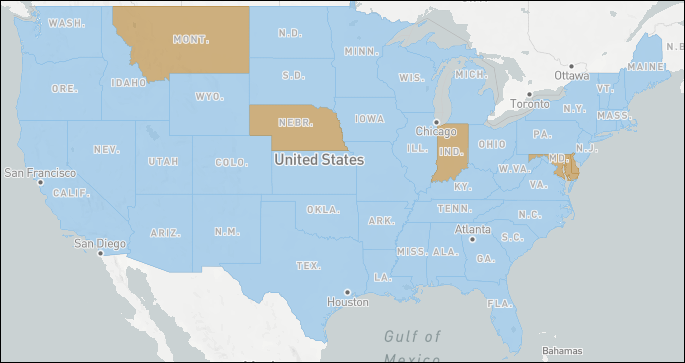A New ‘STEM Opportunity Index’ Maps Openings in the Market
Education companies and organizations now have a state-by-state window into STEM instruction, with the release of a new “STEM Opportunity Index.”
The interactive index, which is in its beta stage, was published by the National Math and Science Initiative, a nonprofit that offers districts training on improving learning around the core STEM subjects: science, technology, engineering, and mathematics.
The organization is aggregating data from 114 publicly available sources so the index reports on 10 conditions, practices, and outcomes that help identify how STEM education measures up in different locales. The map helps users visualize where there are so-called “STEM deserts” because students don’t have access to what they need to learn in those subjects.
On the STEM map below, for instance, the color blue depicts where a state’s teacher certification testing requires STEM content knowledge. The color brown indicates that STEM is not part of certification testing for teachers. Many variations of the U.S. map can be pulled up on a host of STEM-related indicators via the index.

Over the next few months, the index will be expanded to cover how school districts—and even individual schools—are performing on various STEM measures, said Melissa Moritz, the vice president of strategic initiatives at NMSI.
Among the questions companies and nonprofits will be able to answer with the index are:
Where do students report that science is their favorite subject?
Texas had the highest score here, with 60.21 percent of students saying they “agree, or strongly agree” that science is their favorite subject on the National Assessment of Educational Progress. North Carolina came in second at 59.86 percent, and New York at 59.38 percent. Students are showing less love of science in Idaho (44.87 percent) and Alabama (47.9 percent.)
Where do 4th graders have the greatest need for lab supplies?
The answer, also based on NAEP responses, shows that in California, 39.91 percent of schools report “moderate or large access” to lab supplies in NAEP. Thirteen other states are below 50 percent on this indicator. South Carolina had the highest score (85.19 percent), with Texas a close second (84.43 percent.)
What percentage of students met the benchmark for college or career readiness in math based on the 2017 ACT assessment?
Mississippi shows the greatest need for growth, with only 20 percent meeting the benchmark. Nevada had 21 percent in that category. Conversely, Massachusetts had 75 percent of students hit the benchmark, and New Hampshire, 74 percent.
What states have adopted the Computer Science Teachers Association’s K-12 computer science education standards?
Hawaii, Nevada, Iowa, Pennsylvania, Delaware, and Connecticut have adopted these standards.
Businesses Invited to Participate
The STEM Opportunity Index is designed as a resource for businesses, the community, parents, educators, and policymakers, said Moritz.
An organizing principle for this project is to do the legwork that no single individual or organization would be likely to do with so many data sources, she explained.
For companies interested in expanding K-12 STEM education to bolster their workforce pipelines, the index can help them “target support in specific geographic areas,” and make decisions about what kind of support to provide—and to whom, she said.
“The corporate community is very interested in tangible progress and positive outcomes,” Moritz said.
Businesses that sell products to K-12 schools are welcome to provide their feedback about the index, which is still in beta stage, she said. Inquiries and comments should be sent to customerservice@nms.org.
NMSI would also like to upload more data to its index, including proprietary data as appropriate, if businesses or organizations are willing to share it.
“We are seeking additional support to pull down additional data every year,” she said.
Follow EdWeek Market Brief on Twitter @EdMarketBrief or connect with us on LinkedIn.
See also:
- One Pioneering District Leader’s Expectations for STEM Products
- Take a Look at the STEM Approaches Districts Value Most
- The Maker Movement: Understanding What the Research Says
- What K-12 District Leaders Want From Science Products
- Google Expands K-12 Footprint, Acquires STEM-Focused Company Workbench
- $195 Million in Federal Grants for STEM, Computer Science Open for Applications
- ‘STEM Deserts’ in the Poorest Schools: How Can We Fix Them?
